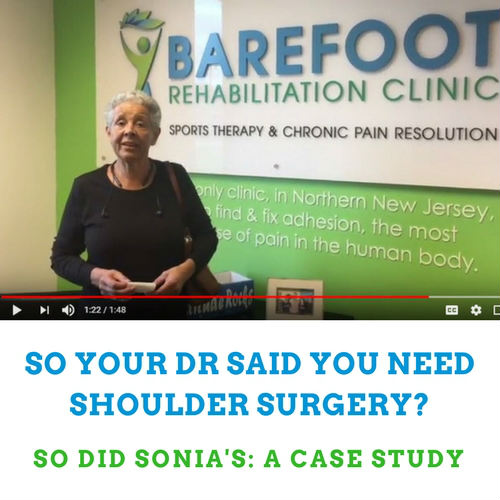
06 Nov Case Study: When Do You Need Shoulder Surgery?
So … your orthopedic doctor says you need shoulder surgery.
But, you don’t want shoulder surgery. You want to be fixed – without surgery.
That’s possible, but not definite.
Let’s see if you need surgery or not.
When Your Surgeon Says “You Need Shoulder Surgery” …
As always, I assume that you didn’t just choose any random surgeon down the street to look at your shoulder. After all, this is your body we’re talking about.
Hopefully, you chose your surgeon based on:
- Your friend’s recommendations of the surgeon’s ability to develop rapport with you.
- The number of success stories the surgeon has and the probability that surgery will fix you.
Filtering your choice of doctor through the lens of their humility allows you to choose someone who has a realistic answer to your pain.
The humble surgeon does surgery on people who need surgery.
The humble surgeon refers out for people who do not need surgery.
This distinction of the “humble doctor” is huge – it allows you to know who you can trust and who you cannot.
The beauty of specialization in our society allows services to reach super high levels of delivering value.
I’m an expert at diagnosing musculoskeletal problems and removing muscle adhesion, the glue that forms in your muscles.
Having an honest surgeon’s opinion gives me, as a conservative care doctor, a lot of value when I can’t fix someone’s shoulder.
If you haven’t chosen your surgeon based on the above conditions, choose again.
Before You Put the Puzzle Together, You Need All of the Pieces
Imagine a three year-old putting a 6 piece puzzle together.
She’s enthusiastically fitting sides together until they fit. Eureka!
Until she has 5 pieces together and can’t find the last piece.
Looking up at you, she exclaims with brute, toddler authority:
Hey, YOU! Where’s puzzle piece?!
You know that if you fail to find her last piece, a severe shit-storm of tantrums and whining await you.
If you ever want to see me throw a tantrum in the office, forget to bring in your MRI images and report – significant puzzle pieces – with you.
LOL.
For you to get out of pain, you and I need to have all of your Pain Puzzle Pieces in front of you.
Fail to do so and get nauseous riding the Medical Merry-Go-Round.
The primary pain puzzle pieces you need are:
- History
- Exam
- Structure Health – Imaging (and other Tests like Vitamin D levels, Blood sugar tests, CAT scans, or tests for Lyme’s disease)
- Muscle Health – Amount of Adhesion and Response to Treatment
Every few weeks, a patient will call our office and have a conversation with one of our wonderful, powerhouse admins.
They’ll mention how:
- they’ve had pain for months to years (the longer you’re in pain, the more likely you belong in our office at Barefoot Rehab).
- they’ve seen more than 3 other doctors without significant relief (the more doctors you see, the more likely you belong in our office at Barefoot Rehab).
- much money they’ve wasted trying to fix this issue (the more money you’ve wasted, the more likely you’re about to throw up from riding the Medical Merry-Go-Round).
- their pain is growing in intensity (our sweet spot for fixing pain at Barefoot Rehab is between 4-8 out of 10).
At the end of the conversation when it’s time to schedule a Diagnostic Visit to look at the first two puzzle pieces, the history and exam, they’ll ask for a FREE consult with me.
Then, our admins will say:
Based on what you told me about this pain, how it’s affected your life, how much money you’ve wasted, and how you’re scared of how the pain will grow and weigh on your life in the future, there is nothing that will come out of a consult with Dr. Chris. The next step is to Diagnose you.
Don’t get me wrong. I get it.
People are scared to give their trust to another doctor. They’re scared to be left without hope one more time. When hurt, any one of us would protect ourselves from getting hurt from one more human being.
Or, quite commonly, they’re trying to use their busted insurance benefits on clinical excellence. It’s not the individual’s insurance that’s busted, it’s the insurance system as a whole.

That’s why everyone who works at Barefoot Rehab is so superbly emotionally intelligent. It’s what’s needed in order to psychologically hold your hand so that you realize you can trust us.
Then, you’ll let us help you.
Finally, we can collect ALL of your puzzle pieces to diagnose what is going on with you.
Before we look at your puzzle pieces, we need to discuss how aware you are of your pain.
Stop Short-Cutting Intake Forms
80% of the diagnosis comes from your history – what you write down on our intake forms.
It surprises me how often patients skip lines on our New Patient Intake forms. It surprised me so much that I started asking patients:
Why didn’t you fill out every line in the intake forms?
One common answer was:
I don’t know. I guess I never paid much attention to the pain and I didn’t think it mattered.
OK – so there’s a lack of mindfulness to the body, ignorance of the body’s signals, or a lack of importance attached to what each symptom means.
The other common answer was:
Your intake forms are longer and intense than most doctors’ forms. And I’ve skipped lines in other intake forms and it never mattered.
Well, maybe that’s why you’re still in pain silly ass.
If you really want to be out of pain, we need all of the right information. These are our puzzle pieces. The longer your pain has lasted, once it’s gone from 2 weeks of pain to 3 months of pain to a year of pain, the more significant every detail of your pain comes.
Don’t ignore your body.
Puzzle Pieces #1 and #2: History and Exam
Sonia is a 69 year-old woman with her own cleaning business.
During our discussions of the history of her pain, I discovered her pain lasted for a year and was 10/10 out of pain when she moved it weird.
Anytime someone says ‘My pain is 10/10’, combined with ‘When I move it weird’, I’m thinking this person probably does need shoulder surgery, or at minimum, an arthogram.
Immediately, I’m thinking, this is not a muscle problem.
Her exam confirmed that she had a structural problem.
Her shoulder range of motion showed pain in the middle of the range. This is called a pain arc and is a hallmark symptom of a labrum or rotator cuff tear.
Below is a video of another patient of ours, Robert, showing a pain arc in the middle of the range. Robert was a candidate for surgery, but luckily, responded to our care and was able to be mostly pain-free by removing the adhesion from his shoulder.
We now have 3 data points contributing to a structural problem that a surgeon would fix:
- 10/10 pain (a “10” is higher than our sweet spot of “4-8”)
- “moving it weird” as opposed to “I feel it at the top or end of any range of motion.”
- a mid-range pain arc (instead of at the end of the range of motion).
Lastly, I felt her muscles. Luckily, I felt a moderate (not a small amount, not a large amount either) of adhesion.
Sonia’s diagnosis was:
- Muscle Adhesion
- Structural Problem (need an arthrogram to confirm what type of structural problem)
There was enough adhesion for me to be comfortable in starting treatment without Puzzle Piece #3, the arthrogram of her shoulder, to see how she responded to treatment.
Sonia’s pain picture looked like this on the Problem Graph:
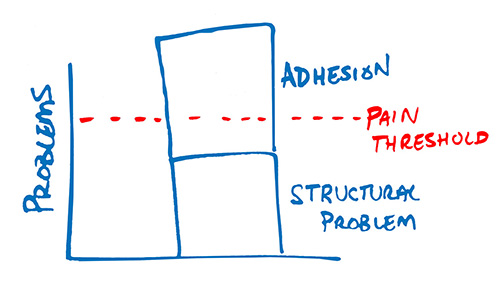
Notice, the structural problem was smaller than the point at which she would feel pain, the Pain Threshold.
When we removed all of her adhesion, her Problem Graph would look like this:
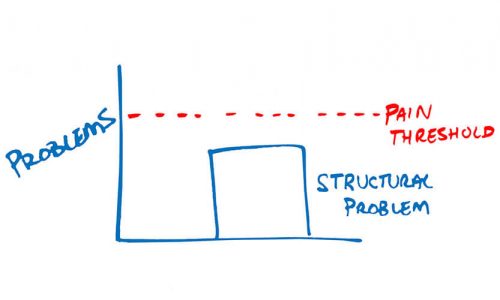
With the adhesion problem gone, Sonia could feel no pain most of the time.
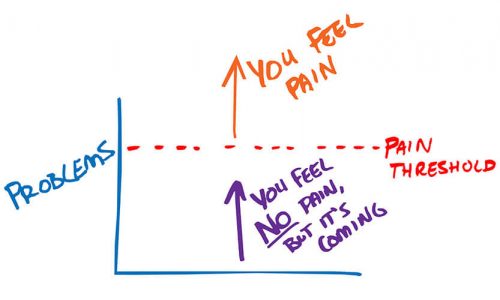
If Sonia had less adhesion in her shoulder than she did, her Problem Graph would look like this:
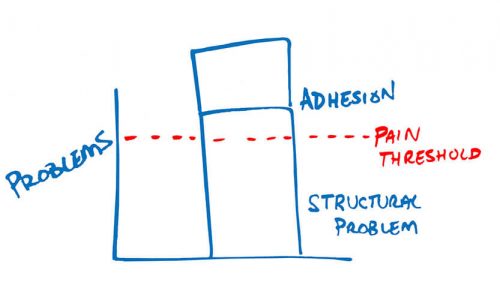
If I had started treatment and her pain and range of motion don’t respond, I’ll know that with the adhesion gone, she’ll still have to get shoulder surgery.
The structural problem block will be above the Pain Threshold by itself and shoulder surgery would be a home run.
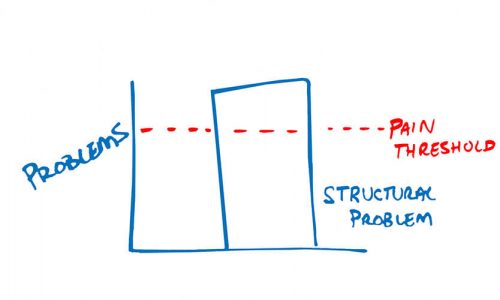
This is why it’s so important to see a doctor who has the ability to grade the severity of each individual problem. It’s the difference between being referred to a surgeon when you don’t need it or wasting thousands of dollars on conservative care when you really do need surgery.
Puzzle Piece #4: Response to Treatment
(Smiling as I write) Watch the video below to see Sonia’s response to treatment.
What you’ll notice from Sonia’s range of motion after 7 treatments is that her shoulder still catches on the way down.
But, for now, her pain is 80% better and she can work, running her cleaning business.
With no more adhesion left in her shoulder to treatment, I told her she still may need surgery in the future because there’s still a structural problem in her shoulder (likely labrum or rotator cuff tear), with 100% certainty.
Given her age and lack of a fitness routine, I referred her to a physical therapist who specializes in scapular and rotator cuff strengthening for a muscle weakness that I left out of the diagnosis above. This physical therapist doesn’t use any machines like stim, ultrasound, dry needling, etc. The type of physical therapist is extremely important because what Sonia needs for her weakness is strengthening, not “feel good” machines.
You Still Might Need Shoulder Surgery, But Do This First
Despite Sonia’s success, I still refer people out for surgery often.
If your shoulder catches like Sonia’s or Robert’s did, know that at minimum, you need an arthrogram to determine how severe the structural problem is in your shoulder.
Not an MRI. An arthrogram. It’s the best test for all structures in the shoulder.
Doctor’s Note: I had a CrossFitting patient two years ago who I couldn’t help by removing his adhesion. I told him he needed an arthrogram, but he got an MRI. It came back negative. I said, “Go back and get an arthogram.” He did and it showed a labrum tear. He got surgery and was pain-free.
When the patient says “I don’t want surgery for X reason.”
I reply back:
You’re not understanding me.
You have a structural problem.
You have no adhesion to remove.
You need a structural solution.
You need shoulder surgery. Not only do you need it, but you’ll feel much better if you get it done. It’s a home run.
But, before you get cut open, have an Integrative Diagnosis doctor check you out.
They could save you from a surgery that you don’t need. Or at minimum, push it off until later.
If you live in North Jersey and want to see if you can avoid shoulder surgery, call us at Barefoot Rehab. 862-205-4847.
 Did your doctor say that you need shoulder surgery? Did shoulder surgery work? If you didn’t get shoulder surgery, what helped you get out of pain so that you could live your life?
Did your doctor say that you need shoulder surgery? Did shoulder surgery work? If you didn’t get shoulder surgery, what helped you get out of pain so that you could live your life?

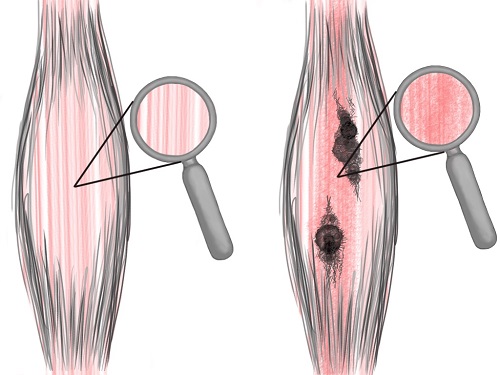
No Comments